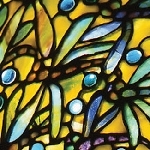 (HOST) Commentator Leora Dowling has some thoughts on why the Louis Comfort Tiffany exhibit at Shelburne Museum is so appealing.
(HOST) Commentator Leora Dowling has some thoughts on why the Louis Comfort Tiffany exhibit at Shelburne Museum is so appealing.
(DOWLING) On a recent evening, in a rare break between showers, I watched the sun set over Lake Champlain. Bright white changed to shimmery yellow, pale apricot, and then an intense pink, as the wind moved low wispy clouds through the deepening blue. I had seen similar effects in the work of Louis Comfort Tiffany at the Shelburne Museum and was struck by how authentic the colors and sense of movement are in a Tiffany sky.
I’m a seasonal guide at the museum, so I’ve had the opportunity to linger over Tiffany’s iconic creations, and I’ve decided that my favorite part of the exhibition is an often-overlooked display case filled with pieces of unused, vibrantly colored Tiffany flat glass. Studying these individual shards of hundred-year-old glass, I’ve come to appreciate what makes Tiffany glass so distinctive and important.

The intense colors and unique dappling, feathering, marbling, and opalescence his glass makers were able to create were an artistic breakthrough. Tiffany refused to paint ON glass, as had been the custom for centuries. Instead, his glass makers improved on techniques dating back to ancient Rome and medieval Europe. They found a way to paint WITH glass, incorporating color, design and texture INTO the glass while it was still in a thick liquid state.
Ladles of colorful molten glass were poured out and mixed together to form sheets of flat glass. Then, as if they were making a puzzle, the designers would search for just the right pieces for soon-to-be petals or leaves. Then they would painstakingly encircle the pieces with copper foil and solder them all together. Bit by bit, the whole picture would emerge.
The pieces of colored glass were, in essence, Tiffany’s paint. When combined with light, his glass caught the ephemeral nature of clouds, the life cycle of a water lily, the energy of dragonflies, and even a summer afternoon in Vermont.
Today there are Tiffany windows in more than a dozen Vermont towns. In most of his church windows, natural motifs surround ecclesiastical figures; but there are three windows at the Union Church in Proctor that are devoid of human beings, leaving God and nature to eloquently speak for themselves.
During the Gilded Age, owning a Tiffany lamp or commissioning a window was de rigeur for the wealthy. But the twentieth century marched in, and World War I changed peoples’ priorities. Extravagant art nouveau was replaced by sleek, modern art deco. Conspicuous consumption went out of style, and Tiffany did, too. All over America people relegated their Tiffany glass to attics – or worse, to the dump.
So those glorious bits of colored glass that were both paint and palette to Tiffany also speak to me of the cycle of innovation, popularity, obscurity, and rediscovery that is so intimately a part of the making of art.
Above: Detail from Dragonfly Hanging Shade, ca. 1906, The Neustadt Collection of Tiffany Glass, New York.